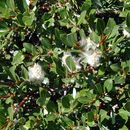mk
имиња во трошки


Salix planifolia (lat. Salix planifolia) - söyüdkimilər fəsiləsinin söyüd cinsinə aid bitki növü.
Salix planifolia (lat. Salix planifolia) - söyüdkimilər fəsiləsinin söyüd cinsinə aid bitki növü.
Salix planifolia is a species of willow known by the common names planeleaf willow, diamondleaf willow, and tea-leafed willow. It is native to northern and western North America, including most of Canada and the western United States. It grows in many types of arctic and alpine habitats in the north, and mountainous areas in the southern part of its range.[2]
Salix planifolia is a shrub varying in size from low and bushy, to long thickets, to a treelike form 9 m (30 ft) in height. The leaves are generally oval in shape with pointed tips, measuring up to 6.5 cm long. They are smooth-edged or serrated, glossy on the upper surface, and sometimes with silky hairs. The inflorescence is a catkin of flowers a few centimeters long.
Salix pulchra, also commonly called diamondleaf or tealeaf willow and sometimes treated as a subspecies of S. planifolia (S. planifolia ssp. pulchra), is now treated as a distinct species.[3]
Salix planifolia is a species of willow known by the common names planeleaf willow, diamondleaf willow, and tea-leafed willow. It is native to northern and western North America, including most of Canada and the western United States. It grows in many types of arctic and alpine habitats in the north, and mountainous areas in the southern part of its range.
Salix planifolia es una especie de sauce perteneciente a la familia de las salicáceas. Es nativa del norte y oeste de Norteamérica, incluyendo Canadá, Alaska y el oeste de Estados Unidos. Crece en muchos tipos hábitat en el norte en zonas árticas y alpinas y en las zonas montañosas en el sur.
Salix planifolia es un arbusto cuyo tamaño varía de bajo a arbustivo, formando desde matorrales a una forma arborescente que alcanza un tamaño de 9 metros de altura. Las hojas son generalmente de forma oval con extremos puntiagudos, de hasta 6,5 centímetros de largo. Son de bordes lisos o dentados, brillantes en la superficie superior, y, a veces con pelos sedosos. La inflorescencia es un amento de unos pocos centímetros de largo.
Salix planifolia fue descrita por Frederick Traugott Pursh y publicado en Flora Americae Septentrionalis; or, . . . 2: 611, en el año 1814[1813].[1]
Salix: nombre genérico latino para el sauce, sus ramas y madera.[2]
planifolia: epíteto latino que significa "con hoja plana".[3]
Salix planifolia es una especie de sauce perteneciente a la familia de las salicáceas. Es nativa del norte y oeste de Norteamérica, incluyendo Canadá, Alaska y el oeste de Estados Unidos. Crece en muchos tipos hábitat en el norte en zonas árticas y alpinas y en las zonas montañosas en el sur.
Salix planifolia est une espèce de saule connu sous les noms communs anglais de planeleaf willow, diamondleaf willow et tealeaf willow (saule à feuilles de thé). Il est originaire du nord et de l'ouest de l'Amérique du Nord, de la majorité du Canada et de l'ouest des États-Unis. Il pousse aussi dans de nombreux types d'habitats aux climats arctiques et alpins, dans le nord et les zones montagneuses de la partie sud de son aire[2].
Salix planifolia est un arbuste variant en taille, de basse et touffue, à une forme arborescente atteignant 9 m de haut. Les branches âgées sont grises alors que jeunes, elles sont rouge noirâtre. Les feuilles sont généralement de forme ovale avec une pointe. Elles mesurent jusqu'à 6,5 cm de long. Les bords sont lisses ou dentelés, le limbe est brillant sur la face supérieure, parfois avec des poils soyeux. L'inflorescence est un chaton de quelques centimètres de long.
Salix pulchra, aussi communément appelé « saule à feuilles de diamant » ou « saule à feuilles de thé » est parfois traité comme une sous-espèce de Salix planifolia (ssp. S. planifolia 'pulchra' ). Il est classé dorénavant comme une espèce distincte[3].
Salix planifolia est une espèce de saule connu sous les noms communs anglais de planeleaf willow, diamondleaf willow et tealeaf willow (saule à feuilles de thé). Il est originaire du nord et de l'ouest de l'Amérique du Nord, de la majorité du Canada et de l'ouest des États-Unis. Il pousse aussi dans de nombreux types d'habitats aux climats arctiques et alpins, dans le nord et les zones montagneuses de la partie sud de son aire.
Salix planifolia là một loài thực vật có hoa trong họ Liễu. Loài này được Pursh miêu tả khoa học đầu tiên năm 1814.[1]
Salix planifolia là một loài thực vật có hoa trong họ Liễu. Loài này được Pursh miêu tả khoa học đầu tiên năm 1814.